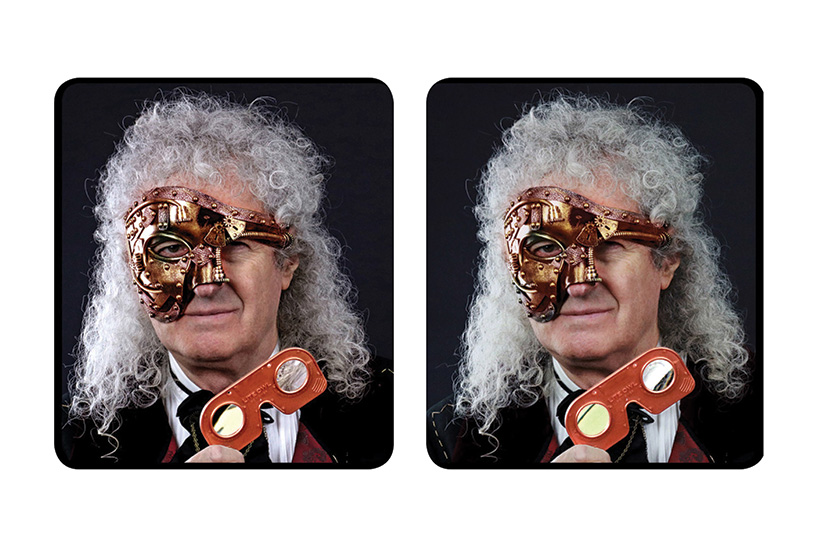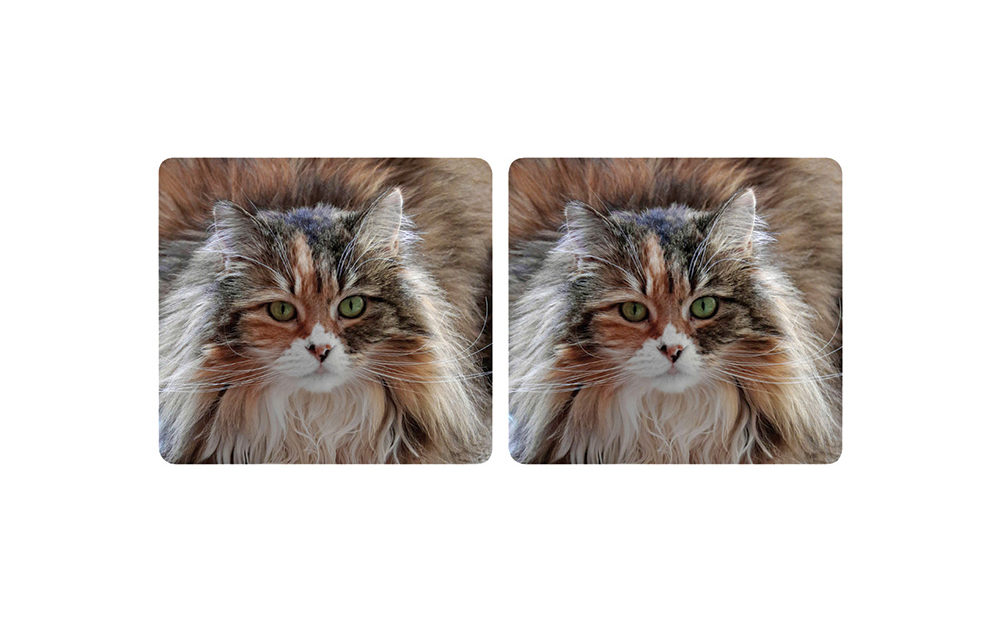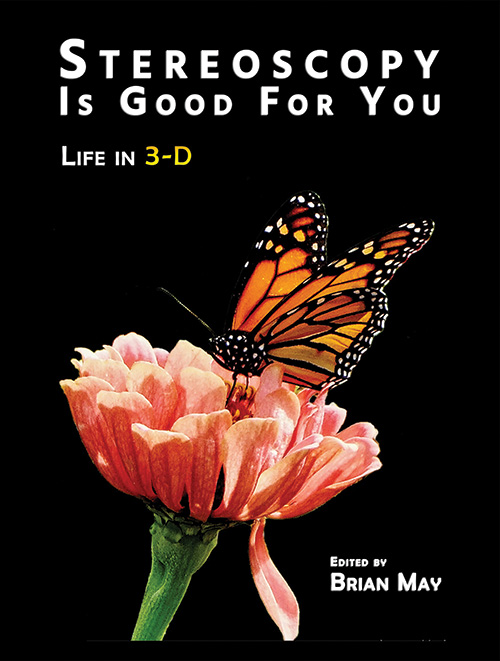Queen guitarist Brian May tells Geoff Harris how the pandemic inspired people worldwide to take great stereo photography. They are celebrated in a new book and exhibition.
As regular readers will know, Brian May is a passionate evangelist for stereoscopic photography, and has been since Queen broke through in the 1970s.
Forget chucking tellies out of hotel windows. He happily recalls, ‘I did a mixture of things when we were on the road, but one of the things I generally did when getting off a plane in a new city was to go and find the local sources of stereoscopic material. It sounds very geeky but it kept me happy!’
Stereoscopy is Good For You: Life in 3D is the latest book from Brian’s London Stereoscopic Company (LSC). It is a collection of ‘stereo’ pictures taken by people all over the world throughout the pandemic. There are some fantastic images in the book as you can see here (they are best viewed with Brian’s Owl viewer, available here).
One vision
First of all, we wondered if Brian was surprised by the huge response when LSC first put out the call on social media for images taken during the lockdowns.
‘To be honest, yes, I didn’t realise how far the message had got. As I say in the introduction to the book, this is a kind of evangelical effort. I still believe we can properly put stereoscopy on the map.
I thought it was great fun seeing what people did when they were in lockdown. Then it clicked, gradually, that what we were doing was gathering together inspiration for other people. Stereoscopic pictures are so much more evocative than “normal” ones and this book became a fantastic opportunity to show this off.’
Brian is also keen to stress that every photographer featured in the new book is an amateur photographer.
‘The majority of LSC’s books have been historical,’ he says, ‘but this book is about photography for the common person, just as AP has set out its own agenda over the years. These are all amateurs who took part. They take stereoscopic pictures because they get a thrill, or a feeling of comfort or connection, or want to capture something that will evoke very strong emotions when they look at it later in life.’
It’s a hard life
In the introduction to the book, Brian notes how fascinating it was to see how so many of the photographers sent an apology for the quality of their work alongside their entry. Did Brian suffer from a similar insecurity with his adventures in stereoscopic photography?
‘That’s an easy question to answer. I get insecure about everything, including my music! I think all artists do. But the older I get the more I think that is an essential part of being an artist, they need this questioning and insecurity to keep updated their view on the world and how they fit into it.’
Stereoscopy is Good for You comes in at nearly 200 pages and features hundreds of photographers. Yet it was a relatively small team of people at LSC that put it together, including Brian.
‘The whole of the LSC is only about six people, and five of us were involved in the book,’ he explains, ‘so it wasn’t a big team but it was a very hard-working one.
You feel a great responsibility when it comes to choosing the images. I don’t like being judgemental, and we just wanted to distil the best of everybody’s work. As it turned out, most of the people who submitted work are represented in some way, but of course some people put in irresistible work, so were featured more than once.’
‘Unlike our previous books,’ he continues, ‘these images came in with every conceivable kind of alignment, framing etc, so it was an enormous job editing each one to get it to the optimum point. The most important consideration was to avoid giving the reader a headache. You need to keep a firm watch on the convergence of the images and now they are aligned to avoid straining the readers’ eyes.
I worked with my “great accomplice” Denis Pellerin, spending hours and hours editing the images into a format which would be both beautiful and comfortable to look at.’
There is a wide choice of subjects in the book. However the images also reflect the limitations on people’s movement during the global lockdowns.
‘I was surprised by how much people got involved in the small things around them,’ Brian notes. ‘Some of the insect images are stunning, and it got me thinking that if it hadn’t been for the lockdowns, some of us wouldn’t have had the time to go into our gardens and explore. Perhaps the most enduring images are of pets – people got particularly close to their pets during lockdown and you really feel that bond.’
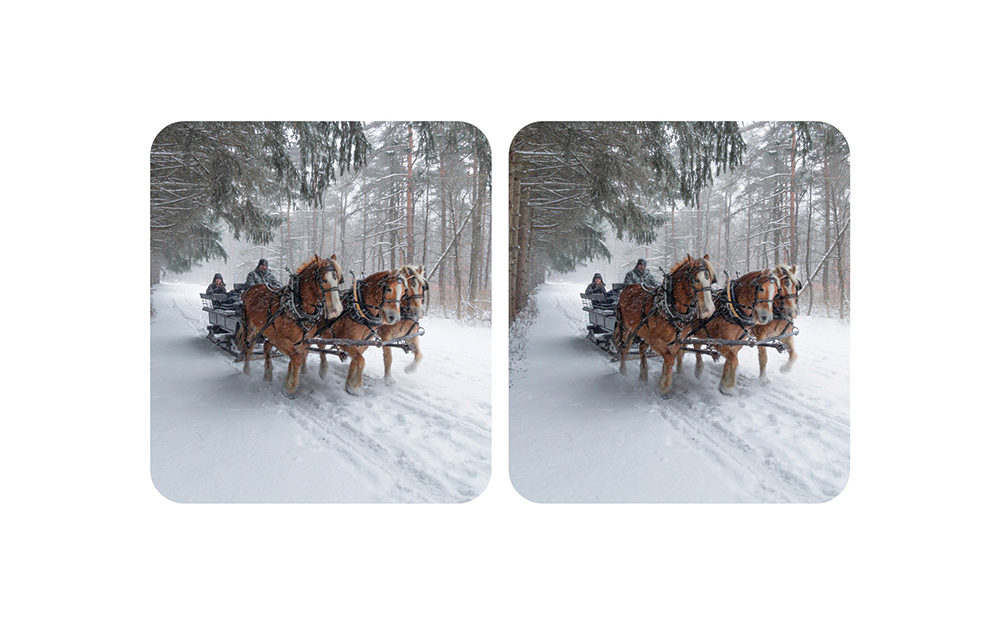
Stereoscopy is Good For You: Life in 3D. Taken by: Andrew Lauren.
Days of their lives
So which images are his personal favourites? ‘It’s hard to choose, but I love the coach and horses (see above). It’s breathtakingly beautiful when you look at it through the Owl viewer. You feel this rush of cold air, hear the crunch of the snow, sense the horses… We did consider it as a cover for the book, but went with the monarch butterfly, which we also love.’
As well as many images from Europe, Stereoscopy is Good for You features work from farther-flung places. ‘Stereoscopy seems to be popular in Japan, certainly in my sphere of influence, and there are some great photographers with whom I communicate with directly.
One in particular, Masuji Suto, has produced the wonderful i3D Steroid app (see below) as well as being a great photographer. South America delivered a lot of images for the book too, and there were lots from the US and Canada.

From Stereoscopy is Good For You: Life in 3D. Taken by: Masuji Suto.
‘A couple of images came from Russia too,’ Brian reveals, ‘and we debated whether to include them. In fact, the book had already gone to press by the time of the Ukraine invasion, but we wondered if we should have taken them out. But I thought, hey, these are images made by common people like us, and they have no influence on their government.
It’s the same with music. With Queen, we have always tried to play to the people and disregard the political situation. Music is about connecting people, and that’s our job, and it’s the same with photography. That said, none of us wants to put any kind of approval on what Russia is doing as a country right now. It’s an incredibly painful situation.’
A real eye-opener
Returning to image making, Brian strongly believes that exploring stereo photography can benefit more conventional photographers, too. ‘This may sound corny, but taking stereo pictures does open your eyes. You see in a different way, as you need to imagine that you can see depth as well as everything else.
I now have an indelible disposition to look at scenes and see them “properly” in stereo. A lot of people go through almost their whole lives without realising they have this wonderful depth of perception. My job as the stereoscopic evangelist is to go, “No, there is a way you can transform your pictures into a format that will enable you to enjoy them forever as you did at the time of capture.”’
Does Brian think that some would-be exponents are put off by the time involved in stereoscopic photography? Or have apps made it much easier?
‘Yes to both,’ he says, ‘but the gap is closing. I can take stereo pictures so quickly now on my iPhone, which is something we talk about in the book. When I show the results, particularly to young people, they are gobsmacked and go around taking pictures of their friends all the time. So yes, it can be instant and can be so penetrating to take a stereo photo of your loved ones. In ten years you will think wow, it’s like I can see them or touch them.’

From Stereoscopy is Good For You: Life in 3D. Taken by: Conny Wetzig,
Brian then talks about his love for analogue photography. He first got the bug when developing and printing images with his father in the family darkroom. He has also memorable stereo images on analogue gear.
‘I have a wonderful antique stereo camera called a Rolleidoscop and the images I took of my kids when they were younger are beyond belief. You get such a strong sense of reality. There is still a magic about analogue and it’s the same in music… analogue has a different quality that you can’t quite get in digital.’
Brian is now 75, but shows little sign of slowing down. He continues to tour with Queen, as well as doing solo work and, of course, is a committed stereoscopy evangelist. So does he personally find stereoscopy is good for him?
‘Yes, it’s a much-needed stress reliever. I always take the equipment on tour with me and I edited a lot of the images for this book while on our last European tour. It’s a great escape, and less stressful than music performance, though I love both.’
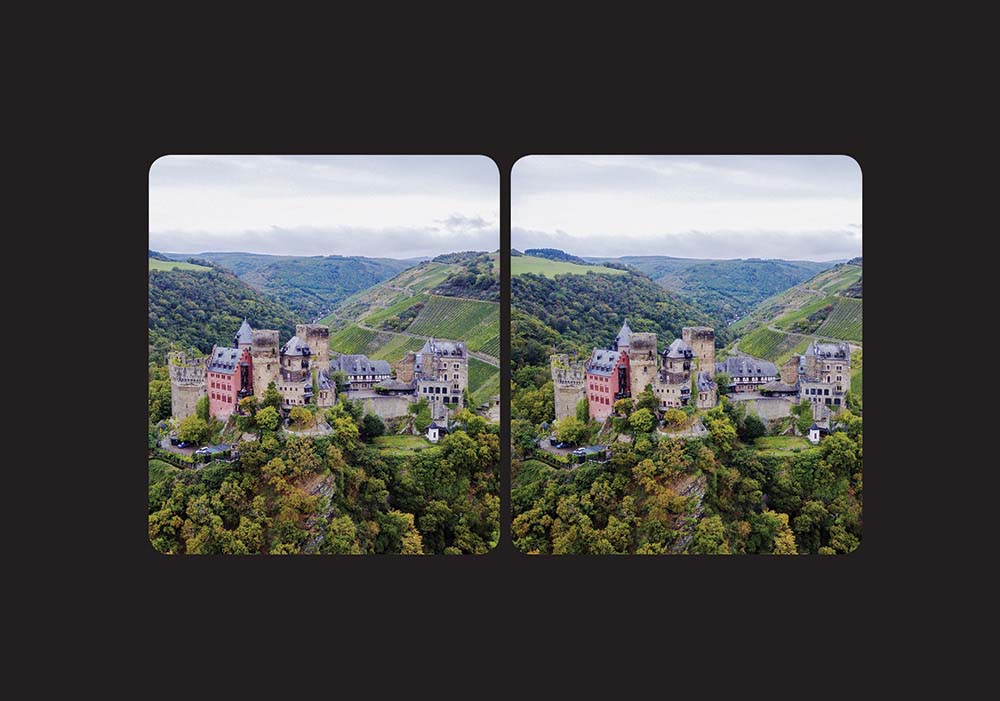
From Stereoscopy is Good For You: Life in 3D. Taken by: Pascal Martiné.
We need it on phones
As mentioned at the start of this interview, Brian developed his own viewer for stereoscopy called the Owl. While it works well, he finds it frustrating that phone makers are not building a similar functionality into their phones.
‘I did a design to turn an iPhone into a stereo camera instantly,’ he reveals, ‘but nobody took me up on it. Yes, we now have the crowdfunded Qoocam, which is a nice stereo stills and movie camera, but it would be nice to have something built into phones.
We all carry them around with us. If phone makers can put three cameras on here (he holds up his iPhone) it would be dead easy for them to put lenses one across the other.’
If the book is a success, Brian is open to the idea of a follow-up, albeit with some caveats. ‘This was toughest book we have done. I have thought of some ways to make the process smoother but at the end of the day, you still have to sit and edit everything to the accuracy of a pixel. I hate seeing inaccuracies in stereo photography books, where some of the pictures are the wrong way round or give you headaches. I had to obsessively check for errors during numerous proofs; it really matters a lot to me.’
Brian May’s favourite app
‘I only use one, i3D Steroid for the iPhone (for Android phones, it’s called 3D Steroid). This is a very nice app and is very cheap, considering the developer, Masuji Suto, updates it for free. Suto-san is always open to suggestions too, a proper genius, and his pictures are also featured in Stereoscopy is Good for You.’ See the app store for your phone: i3DSteroid on the App Store/3DSteroid on Google Play.

Major new exhibition
Brian is steeped in the history of stereoscopic photography. We wondered, if push came to shove, who is his favourite exponent?
‘Ah, that’s easy – TR Williams, who was a master of his craft during the first stereoscopy boom in the 1850s. He had an exquisite eye for detail and composition, and pioneered his own chemical technique and ways of making the viewing cards. TR never advertised. He worked in this little studio where he made portraits and didn’t even have his name above the door, but people flocked there to have their stereo portraits done on daguerreotype.
I published his book Scenes in our Village, chronicling the village where he grew up as a child, and I want to do more to tell his fascinating life story. It’s on my bucket list.’
Last but not least, a leading London photography gallery is showcasing a selection of the images from the new book. The exhibition at Proud Galleries (located at Charing Cross) will run for five-months. It opened on 3 November and runs until 25 March, 2023. Book tickets at here.
Exclusive discount for AP readers
Stereoscopy is Good for You: Life in 3-D features images of over 100 modern stereo photographers. These images were of subjects that lifted their spirits during lockdown. AP readers can get a 20% discount using code ap20 when purchasing the book from the London Stereoscopic Company Website. The offer lasts until 1 December, 2022.
Related articles:
Brian May & Denis Pellerin reveal plans for first International Stereoscopy Day
Brian May wants more of your stereo photos (but hurry up)

